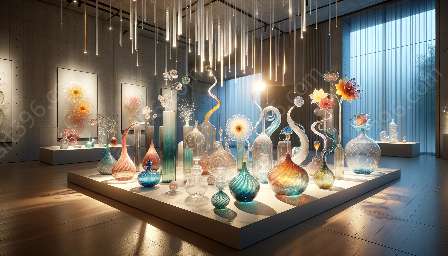Glass casting plays a significant role in architectural and interior design, contributing to the creation of stunning and functional spaces that seamlessly blend artistry and utility. This technique involves the melting of glass and then shaping it into molds to produce a wide array of decorative and structural elements. From custom lighting fixtures to intricate room dividers, glass casting offers design professionals the opportunity to incorporate unique, organic forms into their projects, enhancing the aesthetic appeal and functionality of the built environment.
The Artistic Impact of Glass Casting
One of the most compelling aspects of incorporating glass casting into architectural and interior design is the artistic freedom it affords. Glass, when molded through casting, can take on almost any shape or form, allowing designers to create bespoke elements that complement the overall design concept. Whether it's a whimsical sculptural installation in a public space or an elegant glass partition in a residential setting, glass casting enables architects and interior designers to infuse spaces with a sense of individuality and artistic expression.
Enhancing Spatial Dynamics
When considering the role of glass casting in design, it's essential to recognize its ability to manipulate light and redefine spatial dynamics. The translucency and reflective properties of glass can be skillfully harnessed through casting, enabling designers to craft elements that interact dynamically with natural and artificial light sources. This aspect is particularly impactful in interior design, where glass-cast features can create a sense of openness, luminosity, and depth within a space, ultimately transforming the way occupants perceive and engage with their environment.
Functional Versatility
While the artistic and aesthetic aspects of glass casting are compelling, it's equally important to acknowledge the functional versatility it brings to architectural and interior design. Glass castings can serve as load-bearing structural components, decorative partitions, flooring insets, acoustic fixtures, and more. The adaptability of glass casting allows for the seamless integration of these elements into various design schemes, catering to diverse functional requirements while maintaining a cohesive visual language throughout the space.
Integration with Modern Technologies
The integration of glass casting with modern technologies has expanded the possibilities for architectural and interior design. Innovations in digital modeling and fabrication techniques have enabled the production of intricate, complex glass-cast components that were previously unattainable through traditional methods. This marriage of traditional craftsmanship with cutting-edge technologies empowers designers to push the boundaries of form and function, resulting in the creation of truly remarkable architectural and interior elements.
Sustainable Considerations
Furthermore, the choice of glass as a medium for casting aligns with sustainability goals in design. Glass, known for its recyclability and durability, contributes to the eco-friendly ethos of contemporary architectural and interior projects. By utilizing recycled glass and implementing energy-efficient casting processes, designers can reduce the environmental impact of their creations, fostering a more sustainable approach to design and construction.
Embracing Glass Artistry
It's also important to recognize that the utilization of glass casting in architectural and interior design fosters a deeper appreciation for the artistry and craftsmanship involved in glass production. From traditional hand-crafted pieces to digitally fabricated marvels, the integration of glass artistry into design projects heightens the level of detail, intricacy, and beauty within the built environment, elevating the overall experience for occupants and visitors alike.
Conclusion
In conclusion, glass casting occupies a pivotal role in modern architectural and interior design, offering a wealth of creative and functional opportunities for design professionals. From unleashing artistic expression to shaping spatial experiences, and from embracing sustainable principles to leveraging technological advancements, glass casting stands as a versatile and impactful tool in the hands of visionary architects and interior designers, shaping the aesthetic and experiential landscape of the spaces we inhabit.

